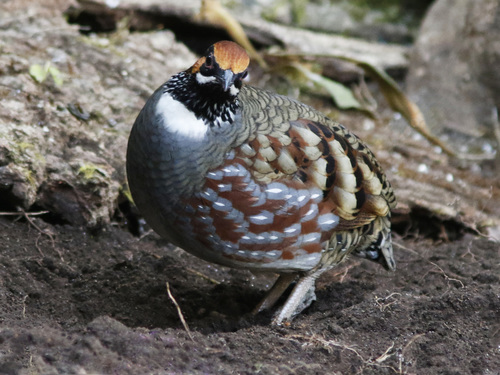
Hill Partridge
The Hill Partridge, a member of the Phasianidae family, represents a diverse group of ground-dwelling birds found across the hilly and mountainous regions of Asia. These birds play a vital role in their ecosystems, primarily as seed dispersers and a food source for larger predators. They are not typically known for significant cultural importance but are appreciated for their subtle beauty and contribution to biodiversity. Their cryptic plumage and elusive nature make them a challenging but rewarding subject for birdwatchers.
26-30 cm
Length
40-45 cm
Wingspan
Least Concern
Conservation Status
Distribution
The Hill Partridge is distributed across the Himalayas, ranging from northern India through Nepal, Bhutan, and into parts of Myanmar, Vietnam, and southern China. They can be found at varying altitudes, typically between 1,000 and 3,000 meters, but sometimes higher or lower depending on the specific region and subspecies.
Lifespan
Unknown in the wild, likely 3-5 years. May live longer in captivity.
Hill Partridge's Habitat
Habitat Types
Temperate forests, Subtropical forests, Bamboo thickets, Shrublands
Climate Zones
Temperate, Subtropical
Adaptations
Hill Partridges have strong legs and feet, well-suited for navigating steep, rocky terrain and scratching for food on the forest floor. Their relatively short, rounded wings allow for quick bursts of flight to escape predators, though they prefer to run and hide.
Variations
Several subspecies of Hill Partridge are recognized, differing slightly in plumage coloration and geographic distribution. These include *Arborophila torqueola torqueola*, *A. t. millardi*, *A. t. batemani*, and *A. t. griseata*.
Appearance
Breeding Plumage
Males generally have a more brightly colored and patterned head and neck, with a black throat and a chestnut collar. Females are duller, with more cryptic brown and buff plumage. There isn't a significant difference between breeding and non-breeding plumage, though colors may be slightly brighter during the breeding season.
Seasonal Feather Changes
Limited seasonal variation.
Sex Based Plumage Differences
Males are more brightly colored, particularly on the head and neck.
Notable Features
Chestnut collar (more prominent in males), Black throat and face markings (more prominent in males), Cryptic brown and buff body plumage, Strong, reddish legs
Diet and Feeding
Primary Foods
Seeds, Berries, Insects, Small invertebrates, Shoots, Roots
Foraging Behavior
Hill Partridges forage on the ground, scratching and pecking amongst leaf litter and undergrowth. They typically feed in small groups or family parties.
Specializations
Their strong legs and feet are adapted for scratching and digging to uncover food.
Seasonal Diet Variations
Diet may shift slightly depending on the availability of food. They may consume more insects during the breeding season when protein requirements are higher, and more seeds and berries during other times of the year.
Behavior
Social Structure
Generally found in small groups or family parties, especially outside the breeding season. During the breeding season, they may be more territorial and solitary.
Communication
Variety of calls, including whistles and chuckles, Visual displays, such as bowing and feather ruffling
Migration
Hill Partridges are generally non-migratory, but they may make short altitudinal movements in response to weather conditions or food availability.
Territorial or Group Behaviors
Males can be territorial during the breeding season, defending their territory against rivals. Outside of the breeding season, they are more gregarious.
Conservation
Threats
Habitat loss and degradation due to deforestation and agricultural expansion, Hunting for food and sport, Climate change
Protection Programs
Some protected areas within their range, Community-based conservation initiatives in some regions
Local National Laws
Protected under wildlife laws in some countries within their range, but enforcement may be variable.
Population Trend
Decreasing
Population Estimates
While the global population is not precisely quantified, it is believed to be declining due to habitat loss and hunting.
Interesting Facts
Hill Partridges are known for their elusive nature.
Their cryptic plumage and preference for dense undergrowth make them difficult to spot.
The genus name *Arborophila* means 'tree-loving'.
Despite this name, they are primarily ground-dwelling birds, though they may roost in trees.
They are important seed dispersers.
They help maintain plant diversity in their habitat.
Faqs about Hill Partridge
Are Hill Partridges easy to see in the wild?
No, they are quite shy and well-camouflaged, making them difficult to observe.
Do Hill Partridges migrate?
They are generally non-migratory, but may move short distances altitudinally.
What is the biggest threat to Hill Partridges?
Habitat loss and hunting are the primary threats to their populations.
Copyright @ Nature Style Limited. All Rights Reserved.
 English
English